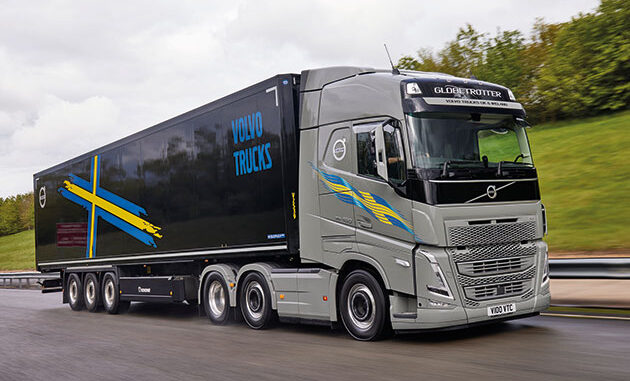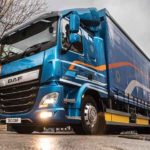
Plaudits for the fuel efficient Volvo FH with the turbo compound engine and I-See predictive cruise control have been in multitude. Transport News takes to the road to see if it stands up to an operator’s way of life.
Images: Tom Cunningham
VOLVO HAS embraced the turbo compound engine, and it seems to be popular with operators as well. Relaunched in 2016, its history dates back to the 1980s when both Swedish truck manufacturers toyed with a technology where exhaust-gas energy is recovered by a turbine and driven into the crankshaft.
Volvo offered turbo compound in 2001 with a D12 500hp engine to boost power and torque. It was available right up to the introduction of Euro 4/5.
These days turbo compound at Euro 6 works off the D13K 12.8 litre, with both 460 and 500hp options. Turbo compound utilises a conventional turbocharger for its normal function of boosting the pressure of the intake charge of air. The exiting exhaust gases still contain considerable energy and powers a secondary turbine, which in turn adds drive to the engine flywheel, adding 300Nm to the engine’s torque output.
Originally used to provide extra power, Volvo’s interpretation is optimised to enhance fuel economy, which Volvo states it does to the tune of around 3.5%.
The Euro 6 rating is met via exhaust gas recirculation (EGR) set at around 10% so no EGR cooler is fitted, with the rest of the work done with selective catalytic reduction (SCR).
Standard D13K 460 (a true 453hp) offers 2,300Nm from 1,000 to 1,400rpm. With the D13TC, that is increased to 2,600Nm from a slightly narrower rev band from 900 to 1,250rpm.
It is all branded as I-Save; turbo compounding and specifically designed rear axles to match the engine’s torque characteristics; all part of a ‘Long Haul Fuel Package’ with an updated map-based I-See system, Volvo Trucks’ predictive cruise control, which analyses and adapts to gradients ahead and includes gearshifting software optimised for long haul applications.
On the road, with Transport News official road test driver, Lochmaben Transport’s Stevie Walker.
WHEN I was informed that my next driver’s impression road test was to be the latest version of Volvo’s fuel sipping 460 FH I-Save, I was somewhat delighted. Having owned and operated one of the earliest versions on a 69-plate I have been more than impressed by the truck and would no doubt have ordered another had it not been for unrealistic lead times.
I bought the I-Save to cover a high mileage contract, had it double shifted and on predominately motorway miles. It was the perfect task for the turbo compound, and I was proved right as it returned some remarkable fuel figures.
It’s not all been rosy, however, as early in its career it suffered a catastrophic engine failure, which resulted in a new engine installed into the FH, however it now continues to work hard for us with around 900,000km and next to no down time. The experience I thought of only as teething trouble and had complete faith that Volvo wasn’t about to allow this to replicate.
The latest version of the I-Save is mechanically the same beast as the 2019 model which had pretty much maxed out in performance, so it has been down to the designers and the software boffins to squeeze a bit more out of the truck.
You have to look close to see some subtle changes to the exterior that aid air flow around mirrors and lower down around headlights and bumper. New V-shaped LED headlights with adaptive full beam give a nice stealthy look to the cab, especially in this particular shade of grey.
Full cab air suspension fitted to the demonstrator gives an enormous range of heights right from Fast and Furious low rider to something that would almost negate the need for a ferry on cross channel operations.
Twin exterior lockers on both sides give best options for all the paraphernalia, including an option for a built-in water tank for hand washing.
Inside the cab remains largely the same visually with a similar dashboard setup and the now familiar rubber ‘birdbath’, which continues to take pride of place in the middle to host keys or any spillages during lunch breaks. It does however have a tendency to fly off on roundabouts when you are least expecting it.
More stuck on than integrated is the addition of a new touch screen infotainment centre which has most of the now expected cool stuff allowing you to connect your phone media (not Apple Car Play yet but I’m sure it’s in the post) DAB radio, Sat-Nav and best of all a user-friendly way to connect Bluetooth.
I still cringe every time I try and fail to connect up to the previous system, possibly the least user-friendly thing ever invented. Digital display replaces the analogue dials helping to bring things up to date along with a rethink on some of the menu controls making everything much easier and less of a fumble as with the previous cab.
The centre console cup holders have been redesigned as the previous generation had a tendency to break. Plenty of interior storage, decent sized fridge and drawer, comfortable mattress with raised back option all make for a comfortable night in.
The leather seats have had a bit of a makeover with additional padding to make long shifts a bit more bearable, in the past I have never found Volvo seats very comfortable, but these are a definite improvement.
Powerful fans combined with perforations on the seat surface allow enough hot or cool air flow to almost lift you off the seat, the perforations however don’t help aesthetically, and the colour isn’t a great choice as it doesn’t remain clean for long no matter how good your house keeping.
The I-Save doesn’t come with the familiar I-Shift gear selector at the side of the seat which I have always been a big fan of (I believe there is a new snazzy version of this on other models but I have yet to experience it).
Instead, the gearbox controls are dashboard mounted in the shape of buttons, the reason for this is to try and discourage drivers from trying to out-think the I-See technology, all too tempting when the gear selector doubles as an armrest.
Out on the road, at this point being the M74 North, the Volvo behaves well and with cruise control set its time to let the technology take over, and there is plenty of technology in this truck, its brimming with the stuff.
Adaptive cruise control giving you the option of going with the flow of the traffic, a red heads-up warning display tells you that you are getting too close to the vehicle in front, and this turns to an audible warning if you get really close before it decides to do the braking for you.
The three stage Volvo Engine Brake does its best to make the brake pedal redundant and is enhanced by the outstanding I-See technology which reads the topography well.
It makes decisions throughout each journey on where and when to brake, coast and accelerate to get the best out of every litre of fuel used. Always learning and improving with each journey; this is amazing technology. If left alone by drivers, who don’t actually know better, I-See will boost the productivity and lower the carbon footprint for any operator willing to invest.
Perhaps my favourite gizmo on the FH is the Lane Keeping Assist, this is effectively an invisible hand which gently steers the truck back if it happens to drift towards the white lines; another amazing piece of kit that will no doubt save lives.
It is worth noting that this is not a fully automatic steering system, it is an assist only and if you were to take your hands off the steering wheel for a set number of seconds, the system acknowledges the lack of driver input, who is promptly reprimanded with an audible alarm.
The 13 litre 460 engine is gifted an extra 300Nm of torque when it has the turbo compound strapped onto it maxing it out at around 2,600Nm. This technology is best suited to operations where the truck gets to stretch its legs a bit and will pay dividends on long haul. The 460 has plenty of power for most situations and keeps up a decent pace throughout the test drive. For those who require a bit more grunt there is always the FH 500 option.
The I-Shift continues to be the benchmark gearbox. Seamless gearchanges, quick and decisive, it seems that all the other manufacturers are always playing catch up with Volvo whose software is constantly improving.
The Volvo is a very peaceful workspace, the extra sound insulation in the new cab allows very little wind or engine noise and only the odd whistle from the turbo as it shuts itself down after it has had a bit of work to do. The full width electric sun visor is faultless when we are treated to a rare bit of November sunshine.
With the stunning Perthshire scenery, the sun shining and sitting behind the wheel of one of the finest vehicles on the road you can’t help but think that truck driving isn’t such a bad career, if only this were the norm.
With the motorway work behind us it’s time to put some of the tech to bed and get a little more involved in the driving of the truck as we leave the Edinburgh bypass for the A702.
The twists and turns on this section of the test route mean that use of cruise control to try and maintain a decent pace can be difficult but the crisp steering and powerful engine brake certainly help.
The air suspension allows for a smooth ride and cab roll is minimal, these are not the roads for these types of trucks, but the Volvo eats it up as well as any I have driven.
With the day at an end, I have to say the technology is remarkable. You are left wondering what the future will bring for the industry in terms of safety and efficiency; two things we can never get enough of, and Volvo continues to beat this path as they offer up products such as the I-Save.
Specification: Volvo FH I-Save Tractor
Cab: Globetrotter.
Engine: D13K460 in-line 6-cylinder with electronic unit injection and turbo compounding. Euro-6d emissions via uncooled EGR and AdBlue SCR.
Maximum power: 453hp at 1,240 to 1,600rpm.
Maximum torque: 2,600Nm from 900 to 1,240rpm.
Gearbox: AT2612F I-Shift 12 speed direct-drive with automated change. TP-LONG software.
Rear axle ratio: 2.31:1.
Wheelbase: 4,100mm.
Suspension: Front suspension type, front, steel parabolic; rear, air with lifting second axle.
Brakes: Disc brakes, with full EBS and Advanced Emergency Braking; disc brake dimensions front and rear, 430mm; middle, 420mm diameter.
Parking brake: Electronically controlled spring brake actuators on first and drive axles.
Secondary brake: VEB+ engine compression brake, max 375kW at 2,300rpm.
Steering: Recirculating hydraulic power assisted.
Wheels: Alcoa Durabright on all axles.
Tyres: Front and mid axle; 385/55 R22.5 Michelin X Line Energy; drive axle: 315/70 R22.5 Michelin X Line Energy.
Tank capacities: Diesel, 480 litres; AdBlue, 100 litres.
Plated weights: Front axle, 8,000kg; mid-axle, 7,500kg; drive axle, 11,500kg.
Kerbweight: 8,750kg (no driver, full tanks).
Trailer: Krone box triaxle 4.0m.
Weather: Dry, bright, 14mph northerly wind, 6 degree centigrade.
Date of test: 23 November 2022.
Sidebar
Route: Starts at Lockerbie Lorry Park (as was) heading north from M74 J16 to Glasgow J4 and joins the M73 towards Denny then M80 north past Stirling. At Dunblane, onto the A9 past Auchterarder to Perth and join M90 south towards Kinross and onto Forth Road Bridge. Turn onto the eastbound M8 then around A720 Edinburgh bypass to A702 heading southbound passing Penicuik and Biggar. At Abington Motorway Services re-join M74 J13 southbound to M74 J16 and finish at Lockerbie Truckstop. Mileage: 191.5.




